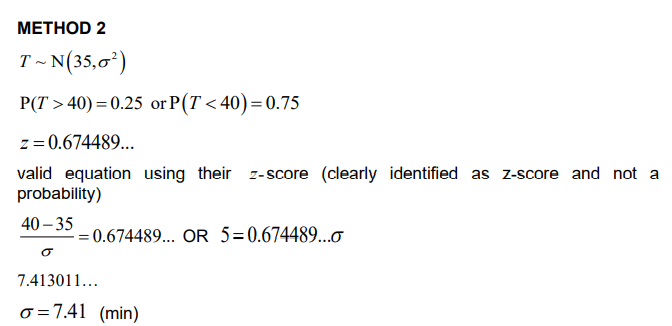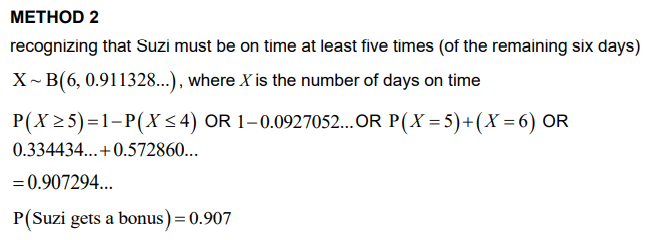Question
The time it takes Suzi to drive from home to work each morning is normally distributed with a mean of 35 minutes and a standard deviation of σ minutes. On 25% of days, it takes Suzi longer than 40 minutes to drive to work.
(a) Find the value of σ.
(b) On a randomly selected day, find the probability that Suzi’s drive to work will take longer than 45 minutes.
Suzi will be late to work if it takes her longer than 45 minutes to drive to work. The time it takes to drive to work each day is independent of any other day.
Suzi will work five days next week.
(c) Find the probability that she will be late to work at least one day next week.
(d) Given that Suzi will be late to work at least one day next week, find the probability that she will be late less than three times.
Suzi will work 22 days this month. She will receive a bonus if she is on time at least 20 of those days.
So far this month, she has worked 16 days and been on time 15 of those days.
(e) Find the probability that Suzi will receive a bonus.
Answer/Explanation
Ans:
(a) METHOD 1
T ∼ N(35, σ2 )
P( T >40) = 0.25 or P(T< 40) = 0.75
attempt to solve for σ graphically or numerically using the GDC
graph of normal curve T ∼ N(35, σ2 ) for P (T> 40) and y = 0.25 OR P( T < 40) and
y = 0.75 OR table of values for P( T < 40) or P (T> 40)
σ = 7.413011…
σ = 7.41 (min)

(b) P(T>45)
= 0.0886718…
=0.0887
(c) recognizing binomial probability
L ∼ B (5, 0.0886718…..)
P(L≥1) = 1 – P (L = 0) OR
P(L≥1) = P (L = 1) + P (L = 2) + P (L = 3) + P (L = 4) + P(L=5)
0.371400….
P(L≥1) = 0.371
(d) recognizing conditional probability in context
finding {L < 3} ∩ {L≥1) = {L=1, L=2} (may be seen in conditional probability)
P(L = 1) + P(L=2) = 0.36532…. (may be seen in conditional probability)
P (L < 3 | L ≥1) = \(\frac{0.36532…}{0.37140…}\)
0.983636…
0.984
(e) METHOD 1
recognizing that Suzi can be late no more than once (in the remaining six days)
X ~ B (6, 0.0886718…) , where X is the number of days late
P (X ≤ 1) = P (X = 0) + P (X =1)
= 0.907294…
P (Suzi gets a bonus) = 0.907
Note: The first two marks may be awarded independently.

Note: The first two marks may be awarded independently.
Question [Maximum mark: 15]
The flight times, T minutes, between two cities can be modelled by a normal distribution with a mean of 75 minutes and a standard deviation of σ minutes.
(a) Given that 2% of the flight times are longer than 82 minutes, find the value of σ. [3]
(b) Find the probability that a randomly selected flight will have a flight time of more than 80 minutes. [2]
(c) Given that a flight between the two cities takes longer than 80 minutes, find the probability that it takes less than 82 minutes. [4]
On a particular day, there are 64 flights scheduled between these two cities.
(d) Find the expected number of flights that will have a flight time of more than 80 minutes. [3]
(e) Find the probability that more than 6 of the flights on this particular day will have a flight
time of more than 80 minutes.
Answer/Explanation
(a), use of inversse normal to find z-score
z=2.0537..
\(2.0537…=\frac{82-75}{\sigma }\)
\(\sigma=3.408401…\)
\(\sigma=3.41\)
(b) evidence of identifying the correct area under the normal curve
\(P\left ( T> 80 \right )=0.071193..\)
\(P\left ( T> 80 \right )=0.0712\)
(C) recognition that \( P\left ( 80 < T< 82\right )\) is required
\(P\left ( T< 82|T> 80 \right )=\frac{P\left ( 80< T< 82 \right )}{P\left ( T> 80 \right )}=\left ( \frac{0.51193….}{0.071193…} \right )\)
=7.19075..
=0.719
(d) recognition of binomial probability
\(X\sim B\left ( 64,0.071193.. \right )\) or \(E\left ( X \right )=64\times 0.071193\)
\(E\left ( X \right )=4.55353…\)
\(E\left ( X \right )=4.56\left ( flights \right )\)
(e)\( P\left ( X> 6 \right )=P\left ( X \geq 7\right )=1-P\left ( X\leq 6 \right )\)
=1-0.83088…
=0.0.1691196..
=0.169
Question
The fish in a lake have weights that are normally distributed with a mean of 1.3 kg and a standard deviation of 0.2 kg.
Determine the probability that a fish which is caught weighs less than 1.4 kg.
John catches 6 fish. Calculate the probability that at least 4 of the fish weigh more than 1.4 kg.
Determine the probability that a fish which is caught weighs less than 1 kg, given that it weighs less than 1.4 kg.
Answer/Explanation
Markscheme
\({\text{P}}(x < 1.4) = 0.691\,\,\,\,\,\)(accept 0.692) A1
[1 mark]
METHOD 1
\(y \sim {\text{B(6, 0.3085…)}}\) (M1)
\({\text{P}}(Y \geqslant 4) = 1 – {\text{P}}(Y \leqslant 3)\) (M1)
\( = 0.0775\,\,\,\,\,\)(accept 0.0778 if 3sf approximation from (a) used) A1
METHOD 2
\(X \sim {\text{B(6, 0.6914…)}}\) (M1)
\({\text{P}}(X \leqslant 2)\) (M1)
\( = 0.0775\,\,\,\,\,\)(accept 0.0778 if 3sf approximation from (a) used) A1
[3 marks]
\({\text{P}}(x < 1|x < 1.4) = \frac{{{\text{P}}(x < 1)}}{{{\text{P}}(x < 1.4)}}\) M1
\( = \frac{{0.06680…}}{{0.6914…}}\)
\( = 0.0966\,\,\,\,\,\)(accept 0.0967) A1
[2 marks]
Examiners report
Part (a) was almost universally correctly answered, albeit with an accuracy penalty in some cases. In (b) it was generally recognised that the distribution was binomial, but with some wavering about the correct value of the parameter p. Part (c) was sometimes answered correctly, but not with much confidence.
Part (a) was almost universally correctly answered, albeit with an accuracy penalty in some cases. In (b) it was generally recognised that the distribution was binomial, but with some wavering about the correct value of the parameter p. Part (c) was sometimes answered correctly, but not with much confidence.
Part (a) was almost universally correctly answered, albeit with an accuracy penalty in some cases. In (b) it was generally recognised that the distribution was binomial, but with some wavering about the correct value of the parameter p. Part (c) was sometimes answered correctly, but not with much confidence.
Question
A market stall sells apples, pears and plums.
The weights of the apples are normally distributed with a mean of 200 grams and a standard deviation of 25 grams.
(i) Given that there are 450 apples on the stall, what is the expected number of apples with a weight of more than 225 grams?
(ii) Given that 70 % of the apples weigh less than m grams, find the value of m .
The weights of the pears are normally distributed with a mean of ∝ grams and a standard deviation of \(\sigma \) grams. Given that 8 % of these pears have a weight of more than 270 grams and 15 % have a weight less than 250 grams, find ∝ and \(\sigma \) .
The weights of the plums are normally distributed with a mean of 80 grams and a standard deviation of 4 grams. 5 plums are chosen at random. What is the probability that exactly 3 of them weigh more than 82 grams?
Answer/Explanation
Markscheme
(i) \({\text{P}}(X > 225) = 0.158…\) (M1)(A1)
expected number \( = 450 \times 0.158… = 71.4\) A1
(ii) \({\text{P}}(X < m) = 0.7\) (M1)
\( \Rightarrow m = 213{\text{ (grams)}}\) A1
[5 marks]
\(\frac{{270 – \mu }}{\sigma } = 1.40…\) (M1)A1
\(\frac{{250 – \mu }}{\sigma } = – 1.03…\) A1
Note: These could be seen in graphical form.
solving simultaneously (M1)
\(\mu = 258,{\text{ }}\sigma = 8.19\) A1A1
[6 marks]
\(X \sim {\text{N}}({80,4^2})\)
\({\text{P}}(X > 82) = 0.3085…\) A1
recognition of the use of binomial distribution. (M1)
\(X \sim {\text{B}}(5,\,0.3085…)\)
\({\text{P}}(X = 3) = 0.140\) A1
[3 marks]
Examiners report
This was an accessible question for most students with many wholly correct answers seen. In part (b) a few candidates struggled to find the correct values from the calculator and in part (c) a small minority did not see the need to treat it as a binomial distribution.
This was an accessible question for most students with many wholly correct answers seen. In part (b) a few candidates struggled to find the correct values from the calculator and in part (c) a small minority did not see the need to treat it as a binomial distribution.
This was an accessible question for most students with many wholly correct answers seen. In part (b) a few candidates struggled to find the correct values from the calculator and in part (c) a small minority did not see the need to treat it as a binomial distribution.
Question
Farmer Suzie grows turnips and the weights of her turnips are normally distributed with a mean of \(122g\) and standard deviation of \(14.7g\).
(i) Calculate the percentage of Suzie’s turnips that weigh between \(110g\) and \(130g\).
(ii) Suzie has \(100\) turnips to take to market. Find the expected number weighing more than \(130g\).
(iii) Find the probability that at least \(30\) of the \(100g\) turnips weigh more than \(130g\).
Farmer Ray also grows turnips and the weights of his turnips are normally distributed with a mean of \(144g\). Ray only takes to market turnips that weigh more than \(130g\). Over a period of time, Ray finds he has to reject \(1\) in \(15\) turnips due to their being underweight.
(i) Find the standard deviation of the weights of Ray’s turnips.
(ii) Ray has \(200\) turnips to take to market. Find the expected number weighing more than \(150g\).
Answer/Explanation
Markscheme
(i) \(P(110 < X < 130) = 0.49969 \ldots = 0.500 = 50.0\% \) (M1)A1
Note: Accept \(50\)
Note: Award M1A0 for \(0.50\) (\(0.500\))
(ii) \(P(X > 130) = (1 – 0.707 \ldots ) = 0.293 \ldots \) M1
expected number of turnips \( = 29.3\) A1
Note: Accept \(29\).
(iii) no of turnips weighing more than \(130\) is \(Y \sim B(100,{\text{ }}0.293)\) M1
\(P(Y \ge 30) = 0.478\) A1
[6 marks]
(i) \(X \sim N(144,{\text{ }}{\sigma ^2})\)
\(P(X \le 130) = \frac{1}{{15}} = 0.0667\) (M1)
\(P\left( {Z \le \frac{{130 – 144}}{\sigma }} \right) = 0.0667\)
\(\frac{{14}}{\sigma } = 1.501\) (A1)
\(\sigma = 9.33{\text{ g}}\) A1
(ii) \(P(X > 150|X > 130) = \frac{{P(X > 150)}}{{P(X > 130)}}\) M1
\( = \frac{{0.26008 \ldots }}{{1 – 0.06667}} = 0.279\) A1
expected number of turnips \( = 55.7\) A1
[6 marks]
Total [12 marks]
Examiners report
[N/A]
[N/A]
